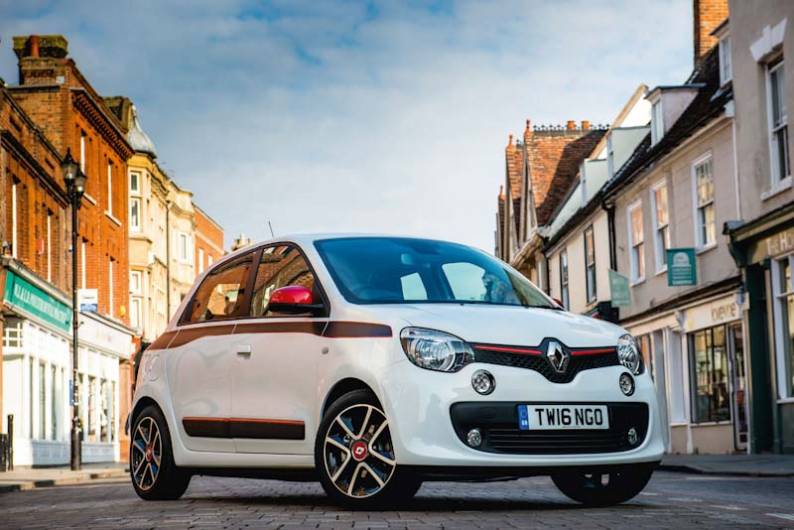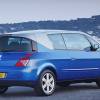
RAC sale – up to 33% off*
• Roadside cover from £5.29 a month†
• We get to most breakdowns in 60 mins or less
• Our patrols fix 4/5 breakdowns on the spot

By Jonathan Crouch
Introduction
Renault's third generation Twingo might look like a conventional city car but under the skin, it offers a very different approach the whole business of urban mobility. The decision to mount its engine at the rear made this model almost unique in this segment, freeing up extra interior space and making the car brilliantly nippy in crowded city streets. If that's just what you're after in an affordable little used runabout, it's well worth a look.
Models
5dr citycar (1.0 petrol / 0.9 petrol) [Expression, Play, Iconic, Iconic Energy, Dynamique, Dynamique S, GT])
History
Citycars need to be short, spacious and manoeuvrable and every designer worth their salt knows exactly how you achieve that. By putting the engine in the rear. That'll give you a shorter bonnet, extra interior space and a turning circle like a London taxi. It'll give you a car like this, Renault's clever third generation Twingo.
Yes, you heard that right: the engine's in the boot - or more accurately, under the boot floor, exactly like a Porsche 911 or, more pertinently in this case, the smart fortwo. It's hardly a new concept: sticking the oily bits back here was pretty popular as long ago as the Sixties when cars like the Hillman Imp, the Skoda 110 and original versions of the Volkswagen Beetle and the Fiat 500 all sold in huge numbers with the motor slung out at the rear.
The modern era though, has belonged to front-engined front wheel drive design. Manufacturers say that cars of this kind are safer and more spacious but the real reason they favour them is that such vehicles are cheaper to produce. Only Daimler's dinky smart brand begged to differ on the subject, proving at the turn of the century with the car that would become their two-seater fortwo model that the concept could still work in an up-to-the-minute urban runabout.
Smart were convinced the configuration could be made to work with a properly-sized four-seater citycar too and in 2008, convinced Renault to join them in developing one. With a history of innovation dating all the way back to 1993, the French brand's smallest Twingo model would, it was felt, be well suited to such an unusual drive layout - and claimed to be in this third generation guise, launched here in the Autumn of 2014. It was developed - and built - alongside smart's forfour model but apart from that car, there was no other four-seater compact vehicle on the market in this period daring to be different in quite the same way. Sales though were modest and the car was quietly dropped in early 2019.
What You Get
Like us, you might think of a typical modern citycar as being a pretty space-efficient thing. Then you come to this MK3 model Twingo and realise just how much more is possible. Here's a design so different from its conventional predecessor that you might wonder if a couple of generations have been skipped while you weren't looking. Outside, it's 10cms shorter than its predecessor, yet somehow inside, it's 33cms longer. The bonnet's tiny and the turning circle's tighter than that of a taxi. Such are the benefits of Renault's decision to put the engine in the rear.
Being rear-engined defines this 3.5-metre-long car in other ways too. With no oily bits at the pointy end, the front wheels could be pushed right to the corners, which improves stability - as well as increasing cabin space to such an extent that the interior of this Twingo is virtually as big as that of a Renault Clio supermini from the next class up. As a result, some at the launch of this model hailed it as the most significant small runabout we'd seen since the original Mini.
You certainly wouldn't guess that on first acquaintance with this car if you approached the thing unfamiliar with the thinking behind its development. The styling is, after all, friendly but unremarkable, with wide upper and lower front grilles, the higher one housing a large Renault diamond logo flanked by headlamps topped with indicators meant to resemble eyelids. And daytime running lights in the form of four luminous points. In profile, wide side protectors adorned with 'Twingo' lettering guard against scratches in parking areas, while hidden rear door handles aim to give the car a coupe-like appearance. At the rear, wide shoulders which stretch from the sides are supposed to be a throwback to Renault's old 5 Turbo hot hatch and a wide glass tailgate neatly integrates with the rear lights, stretching down to bumper level and the area where the engine is housed.
Ah yes, that engine. We keep coming back to that don't we? Its rear-mounted placement does, after all, define almost everything about this Twingo. This French maker isn't of course the first to put forward the concept of this configuration in a citycar. The rival Volkswagen up! was also originally designed that way, before the German manufacturer got cold feet at the last minute worrying about just how expensive it would be to build in that format. Renault got round that problem by sharing its development costs with Daimler's smart brand, whose resulting forfour model rolled down the same Slovenian production line as this Twingo.
Cutting costs though, was just one of the issues the two companies had to overcome in perfecting a four-seater citycar design with the engine slung out-back. Some potential buyers, they knew, would worry about the safety and stability of a little hatch that was so configured. And virtually all likely buyers would probably assume that re-locating the power source to the boot would severely compromise luggage space.
In answer to these issues, the engineers were ingenious, primarily in mounting the engine at a 49-degree angle. That not only stopped it intruding into the cargo area but also meant that in a rear-end collision, the mechanicals would be pushed beneath the passenger cell. Of course, making all of that work meant a fundamental re-design for the three cylinder petrol units Renault had in mind for this car. It was worth the effort though, for the result is a powertrain placement so unobtrusive that this car actually has more interior space than its front-engined predecessor rather than less. And 12cms of extra wheelbase too.
For proof of that, you've only to lift the glass tailgate. This is the only area available for luggage storage. What room there is beneath the bonnet is taken up by a combination of radiator, fluid reserves and crash structures. Just as well then, that it's remarkably roomy in the boot. Yes, the boot floor is quite high because that engine sits beneath it, but there's 188-litres of space on offer - or as much as 219-litres if you tilt the rear seatbacks forward to their 90-degree angled 'cargo position'. True, that second figure's still nothing like as much as you'd get in period rivals like Fiat's Panda, Hyundai's i10 or the Volkswagen up! with its SEAT and Skoda clones. But it's better than any other citycar from this time can offer.
Where this Twingo really does have an advantage though, is when you push forward the rear bench, split 50:50. It isn't just that the 980-litre capacity this reveals is nearly class-leading from tiny cars of this time - around 30% more than you'd get in, say, Peugeot, Citroen or Toyota citycars for example. It's also the usability of the beautifully flat space, emphasised primarily by the fitment of a unique feature in this class of car - a fold-flat front passenger seat. Thanks to this, astonishingly long loads of up to 2.31-metres in length can be accommodated - say an IKEA flatpack bookcase or a full-sized double base. In a citycar!
Up-front, you'll find yourself sitting comfortably and commandingly in a position that further aids the way that the short stubby bonnet makes parking placement so straightforward. You do though, have to get beyond entry-level trim to get height adjustability for both seat and steering wheel and, as with many citycars, you might be irritated to find that that wheel can't be specified to alter for reach. Look through it and you'll find a semi-circular speedometer framing a digital display clearly designed by Renault's development partner smart. It's not to our taste but it is clear and readable.
Most eyes though, will be drawn towards the centre console, particularly in a plush model fitted with the brand's clever R-Link 7-inch colour multimedia touchscreen. From here, as well as controlling the stereo and the sat nav, there's the potential to get economy driving tips, use text-to-speak messaging and surf the internet to download a range of Renault-sourced apps for things like Email, Facebook, Twitter News and fuel prices. It's really very clever indeed.
If you haven't got a car whose original owner paid the extra for the R-Link package, then your Twingo will instead come with the brand's clever 'R&GO' package, allowing almost any smartphone or tablet to be attached to the fascia via a universal fixing cradle that has its own USB connect and power supply. You simply connect up your device and download the free 'R&GO' app onto it. This will instantly give you access to navigation, extended communication, multimedia and trip computer functions. It'll even show a rev counter display, which is presumably why, rather frustratingly, one isn't provided within the instrument binnacle.
All of this cleverness may be intended to distract your attention away from the fact that as a whole, the cabin isn't as classy and solid as that you'd find in, say, Volkswagen's citycar design. In compensation though, it is one that can be trimmed far more individually to suit personal tastes thanks to interchangeable panels that can be colour co-ordinated to match the upholstery and even a removable 2.6-litre centre storage box. Storage for small items is in fact quite plentiful, with three cupholders, 3.0-litre pockets in the front doors, a 2.0-litre console between the front seats and a 6.4-litre glovebox.
At the back, plusher versions get further 2.9-litre pockets in each rear door and the was the option of nets that'll hold stuff in space in the 29-litre space you'll find under the rear seats. But what's it like if you're going to be sitting at the back for any length of time? Well, for a start, there's only space for two. Some citycars from this time - Fiat's Panda for example - offer the option of a third belt so three small children could be carried if necessary, but Renault never did. On the subject of your kids, they might find it a bit annoying to find that here, as with some other models in this class, you don't get proper wind-up windows: just opening flaps.
Having said all of that, there are important pluses to consider in terms of what's provided in the back of this Twingo. For a start, access through the wide doors is very good. Yes, we do miss the sliding rear bench the MK2 model used to offer, but to some extent, you no longer need it because thanks to a 13.6cm increase in rear kneeroom, there's significantly more leg space than you might be expecting. Provided you don't don't get a car whose original owner ordered the optional electric panoramic fabric folding sunroof, headroom's good too.
What You Pay
Please fill in the form here for an exact up-to-date information.
What to Look For
Most Twingo owners we came across were pretty satisfied, but inevitably, some issues were thrown up by our survey. We came across a number of glitches with the R-Link2 infotainment and sat nav system - things like out-of-date maps and issues with DAB drop-out. Examine for flaking of paint on the bumpers and check that the air conditioning works and that the pixels on the centre display are all good. Also check for rear bumper scrapes. Also check that the Bluetooth pairs reliably with your phone handset. Whatever variant you're looking at, check tyres, exhausts and front suspension alignment carefully and try to establish if the previous keeper was diligent in the car's upkeep. Look for parking scratches on the alloys and evidence of child damage on the interior plastics and upholstery. All of these issues are common and could give you scope for price negotiation.
City cars can lead a hard life, so a fully stamped up service book is highly desirable. With heavy town use comes worn brake pads and discs, so check the life left in those, while if the car's mainly done short journeys the battery may be on its last legs too.
There were a few recalls you should be aware of. Make sure they've been sorted by the dealer if the car you're looking at might be affected. One related to the seatbelt latches of Twingos made between October and November in 2014; these could separate from the buckles in the event of a collision. Renault dealers should have recalled affected cars and replaced the relevant seatbelt buckles. There was a possibility that the upper part of the bonnet skin could detach from the rest of the bonnet due to poor adhesives on examples built between May 2014 and July 2015. Dealers were instructed to add reinforcements to the bonnet skin to prevent it from separating. Similar to that recall, the skin of the rear spoiler could potentially separate due to poor adhesives being used on cars built between May 2014 and December 2016, so dealers should have reinforced the spoiler on affected cars to prevent this issue from occurring.
Replacement Parts
(approx based on a 2017 Twingo 1.0 70PS ex VAT) Day to day consumables for the Twingo are in line with what you'd expect. An oil filter is around £4-£8. A wiper blade will cost around £3-£10. Front brake pads sit in the £24 to £37 bracket for a set. Front brake discs sit in the £28-£68 bracket, but you can pay over £90 for pricier brands. A radiator is in the £105 bracket. A water pump is around £25-£57. A headlamp is around £136. A door mirror cover is around £14. A mirror glass is around £23.
On the Road
So, how does it feel to drive? Well to be honest, if you weren't told beforehand that the engine was in the back, you probably wouldn't realise the fact - which is probably about as big a compliment as we could pay Renault regarding this Twingo's handling neutrality. Essentially, though the driving position is a little more commanding than most, in every other respect, on first acquaintance at least, this feels just like any other modestly-powered city runabout.
Or at least it does until you come to tightly twirl the wheel. In this car, the front wheels can turn to an impressive 45 degree angle: more typically, urban runabouts are limited to about 30-degrees. As a result, this car offers a super-tight turning circle of just 8.59m - which is pretty much on par with a London taxi cab and over a metre tighter than any other rival can offer. Most original buyers opted for the base 70PS 1.0-litre SCe petrol unit, three cylinders in size - as is common in this segment - but offering a mere 91Nm of pulling power, which explains the distinctly leisurely performance. If you really can't face going quite that slowly and feel prepared to pay a little more for your Twingo, then you should seek out the other mainstream engine on offer, the TCe 0.9-litre turbo unit. This was mainly offered in 90PS form, but between 2016 and 2018, a rare Twingo GT junior hot hatch with a 110PS version of this unit was offered.
Overall
Here was another example of Renault once again being willing to do things a little differently. This company has often been at its best when it tears up the rulebook. It did that way back in 1993 in creating the original Twingo model and again did so here with that car's appealing third generation successor. The almost unique selling point in this case, the rear wheel drive layout, ought to be just another engineering solution, though a very intriguing one. In practice though, it's more than that, conferring upon this car a different feel and giving it a more individual character you can then further personalise to your heart's content.
That specialness - that individuality - is something you'll enjoy every day in ownership of this Renault. When marvelling at how easy it is to see out of: how simple it is to park: and how tightly it can turn. In other words, it's about more than just stickers and colour co-ordination. The technology's supremely user-friendly too, smartphone-savvy right across the range. And in summary? Well it's true that some other citycar rivals from this period might be cheaper, slightly more efficient or a little better built. But try any one of them after living with a Twingo and you might well find the ownership proposition a little mundane and conventional. Isn't life too short for that? If you think that it is and you're shopping in this segment, then here's a great place to start.







